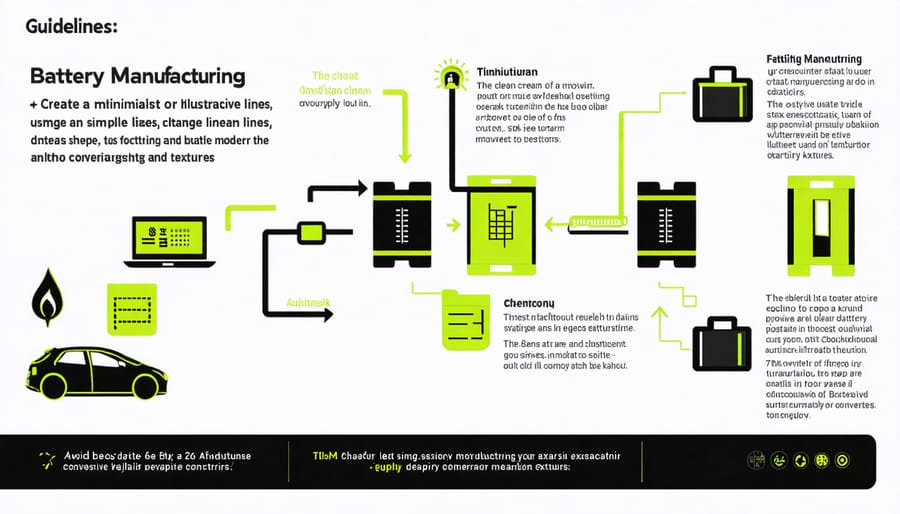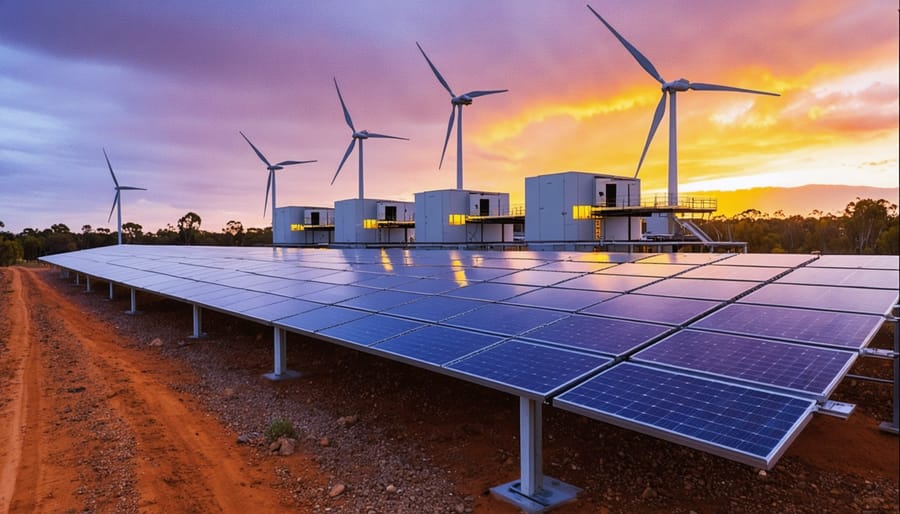Battery storage manufacturers are revolutionizing Australia’s energy landscape, driving the nation’s clean energy revolution with unprecedented momentum. From Tesla’s groundbreaking Megapack facility in Queensland to the emerging local powerhouses like Energy Renaissance in New South Wales, these innovators are transforming how we capture, store, and distribute renewable energy across the continent.
The global battery storage market’s explosive growth – projected to reach $400 billion by 2030 – has positioned Australian manufacturers at the forefront of sustainable energy solutions. Leveraging our abundant lithium resources and world-class research capabilities, local manufacturers are developing advanced storage technologies that promise to solve the intermittency challenges of renewable energy.
As households and businesses increasingly demand reliable, sustainable power solutions, Australian battery manufacturers are stepping up to deliver cutting-edge storage systems that combine performance with environmental responsibility. Their innovations are not just powering homes and businesses; they’re creating thousands of green jobs and establishing Australia as a global leader in energy storage technology.
This surge in domestic manufacturing capability represents a critical turning point in Australia’s energy independence and environmental sustainability, marking the beginning of a new era in clean energy infrastructure.
Leading Battery Storage Manufacturers in Australia

Local Manufacturing Champions
Australia’s battery manufacturing landscape is showing promising growth, despite facing some Australian battery industry limitations. Leading the charge is Energy Renaissance, whose Renaissance One facility in Tomago, NSW, represents a significant milestone in domestic manufacturing. The facility produces lithium-ion batteries specifically designed for hot climates, demonstrating Australian innovation at its finest.
Century Yuasa, based in Queensland, has been a longstanding pillar of Australian battery manufacturing, specializing in both automotive and industrial batteries. Their commitment to quality and local production has helped maintain Australia’s manufacturing capabilities for decades.
Sonnen, while originally from Germany, has established a significant manufacturing presence in Adelaide, creating local jobs and contributing to South Australia’s renewable energy ecosystem. Their facility produces home battery systems that are helping thousands of Australian households achieve energy independence.
Redflow, headquartered in Brisbane, showcases Australian ingenuity with their zinc-bromine flow batteries. Their unique technology offers advantages in harsh climates and long-duration storage applications, proving that Australian manufacturers can compete on the global stage with innovative solutions.
These manufacturers aren’t just creating products; they’re building communities and supporting local economies. Their presence has sparked the development of specialized training programs and created skilled job opportunities across the country. Through strategic partnerships with research institutions and government initiatives, these companies are helping position Australia as a key player in the global battery storage market while addressing local energy challenges.
International Companies with Australian Operations
Several global battery manufacturers have established a strong presence in Australia, recognising the country’s growing renewable energy market and strategic location in the Asia-Pacific region. Tesla made waves in 2017 with its landmark Big Battery installation in South Australia, subsequently expanding its operations and partnerships across the country. The company maintains a network of certified installers and continues to supply both residential and utility-scale storage solutions.
Samsung SDI has strengthened its Australian footprint through partnerships with local distributors and energy retailers, offering high-quality battery solutions for both residential and commercial applications. Similarly, LG Energy Solution has built a robust presence, particularly in the residential sector, working closely with Australian solar installers and energy providers.
Chinese giant CATL has also entered the Australian market, focusing primarily on utility-scale storage projects and electric vehicle applications. The company has formed strategic partnerships with local renewable energy developers and is exploring opportunities for local assembly facilities.
These international players bring world-class technology and expertise to Australia while creating local jobs and contributing to the country’s clean energy transition.
Innovation and Technology Development

Research Partnerships
The Australian battery storage industry thrives on strong partnerships between manufacturers and leading research institutions. These collaborations are driving innovation and pushing the boundaries of energy storage technology. The CSIRO, Australia’s premier research organization, works closely with multiple manufacturers to develop next-generation battery technologies, focusing on improved efficiency and sustainability.
The University of New South Wales’s renowned solar research team partners with several battery manufacturers to optimize integration between solar panels and storage systems. Meanwhile, the University of Queensland’s energy innovation hub provides real-world testing facilities where manufacturers can validate their latest battery developments under Australian conditions.
These partnerships have yielded impressive results, including breakthrough developments in thermal management systems and advanced battery management software. The Australian National University’s battery storage research program has helped local manufacturers improve their products’ lifespan and performance, particularly in extreme weather conditions.
Industry-academia collaboration extends beyond research to include training programs that build workforce capability. This knowledge transfer ensures Australia maintains its competitive edge in the global battery storage market. Several manufacturers also participate in government-funded research initiatives, combining resources and expertise to accelerate the transition to renewable energy storage solutions.
Emerging Technologies
The battery storage landscape is rapidly evolving with groundbreaking innovations reshaping the industry. Leading manufacturers are developing smart storage systems that integrate artificial intelligence to optimize energy distribution and storage efficiency. These next-generation batteries feature advanced materials like solid-state electrolytes, promising higher energy density and improved safety.
Australian manufacturers are particularly focused on developing heat-resistant batteries suited to our climate, with thermal management systems that maintain optimal performance even during scorching summers. Flow batteries are gaining traction, offering scalable storage solutions for large-scale renewable energy projects, while sodium-ion technology emerges as a cost-effective alternative to lithium-ion batteries.
Manufacturers are also embracing circular economy principles, designing batteries with recyclable components and implementing take-back programs. The integration of blockchain technology for battery passport systems ensures transparency in supply chains and validates sustainable sourcing practices.
Perhaps most exciting is the development of bi-directional charging capabilities, allowing batteries to not only store energy but also feed it back into the grid when needed, creating a more resilient and flexible energy network for Australia’s renewable future.
Manufacturing Capabilities and Infrastructure
Production Capacity
Australia’s battery storage manufacturing sector has seen remarkable growth in recent years, with production capacity expanding to meet increasing demand for renewable energy solutions. Major manufacturers like Energy Renaissance and sonnen have established significant manufacturing facilities, with Energy Renaissance’s Renaissance One facility in Tomago, NSW, capable of producing up to 5.3 GWh of batteries annually.
The sector’s combined manufacturing capability now exceeds 10 GWh per year, with several facilities operating at full capacity to meet both domestic and export demands. This expansion has created over 3,500 jobs across the manufacturing value chain and contributed significantly to Australia’s clean energy ecosystem.
Local manufacturers have demonstrated impressive scalability, with many facilities operating advanced automation systems that enable rapid production scaling. For instance, South Australia’s Hornsdale Power Reserve, powered by Tesla batteries, showcases the potential for large-scale manufacturing and deployment.
Recent investments in manufacturing infrastructure have boosted production efficiency, with modern facilities achieving up to 95% automation in their assembly lines. This technological advancement has not only increased output but also improved product quality and consistency.
Looking ahead, planned expansions and new facility developments are expected to double current production capacity by 2025, positioning Australia as a significant player in the global battery storage market. This growth is supported by strong government initiatives and increasing private sector investment in manufacturing capabilities.
Supply Chain Integration
Australian battery storage manufacturers are increasingly focusing on developing robust local supply chains to enhance their manufacturing capabilities and reduce dependence on international suppliers. This shift towards local integration has created new opportunities for Australian businesses while strengthening the resilience of the domestic battery industry.
Leading manufacturers are partnering with local mining companies to secure reliable access to critical materials like lithium, nickel, and cobalt. These partnerships have led to the establishment of processing facilities near mining sites, reducing transportation costs and environmental impact. Companies are also implementing innovative battery recycling initiatives to create circular supply chains, ensuring valuable materials are recovered and reused in manufacturing.
The development of technology hubs in regions like Western Australia and South Australia has attracted component manufacturers, creating industrial ecosystems that support battery production. These clusters facilitate knowledge sharing, reduce logistics costs, and accelerate innovation through collaboration.
Local supply chain integration has also generated significant employment opportunities, with estimates suggesting the sector could create up to 34,700 jobs by 2030. Several manufacturers have established training programs in partnership with TAFEs and universities to build a skilled workforce capable of supporting the growing industry.
The success of these integration efforts is evident in the reduced manufacturing costs and improved production efficiency reported by local manufacturers, positioning Australia as a competitive player in the global battery storage market.

Future Growth and Opportunities
Market Expansion
The battery storage manufacturing sector is experiencing unprecedented growth, with market projections indicating a surge in demand over the next decade. Industry analysts forecast the global battery storage market to reach $31.2 billion by 2029, with Australia positioned as a key player in this expansion.
The Asia-Pacific region, including Australia, is emerging as a powerhouse in battery manufacturing, driven by increasing renewable energy adoption and government support for clean energy initiatives. Major manufacturers are scaling up their operations, with several companies announcing plans to establish new manufacturing facilities across Australia’s major industrial hubs.
This growth is particularly evident in South Australia and Victoria, where state governments have implemented favorable policies to attract battery manufacturers. The expansion is creating thousands of new jobs while strengthening Australia’s position in the global supply chain.
Market opportunities are expanding beyond traditional solar storage applications. Electric vehicle adoption is driving demand for high-capacity batteries, while grid-scale storage projects are becoming increasingly common. Manufacturers are also exploring innovative applications in mining operations and remote communities, where reliable energy storage is crucial.
The future looks particularly promising for manufacturers focusing on sustainable and recyclable battery technologies. With Australia’s abundant lithium resources and growing expertise in battery technology, local manufacturers are well-positioned to capture a significant share of both domestic and international markets. This expansion is supported by rising investment in research and development, creating a robust ecosystem for innovation in battery storage solutions.
Government Support and Initiatives
The Australian government has emerged as a strong advocate for the battery storage manufacturing sector, recognising its crucial role in the nation’s renewable energy future. Through initiatives like the Modern Manufacturing Strategy and the Battery Manufacturing Precinct, substantial funding has been allocated to boost domestic manufacturing capabilities.
A standout example is the $1.3 billion Modern Manufacturing Initiative, which includes battery technology as a priority sector. This program provides matching grants to manufacturers, helping them scale operations and enhance innovation. Additionally, the Clean Energy Finance Corporation has established a dedicated $200 million fund specifically for grid-scale battery projects and manufacturing facilities.
State governments are also playing their part. South Australia’s commitment to becoming a battery manufacturing hub has attracted international investors, while Victoria’s Energy Innovation Fund has supported several battery manufacturing startups. Queensland’s Battery Industry Opportunities for Queensland strategy demonstrates the state’s dedication to fostering this growing sector.
Tax incentives and research grants have been instrumental in attracting global manufacturers to establish facilities in Australia. These support mechanisms, combined with streamlined approval processes for new manufacturing facilities, have created a fertile ground for industry growth.
The government’s support extends beyond financial assistance, encompassing skills development programs and research partnerships between manufacturers and universities. This comprehensive approach ensures Australia builds not just manufacturing capacity, but also the expertise needed to lead in battery technology innovation.
As Australia strides towards a renewable energy future, the role of battery storage manufacturing emerges as a crucial cornerstone of our sustainable development. The growth of this industry not only strengthens our energy independence but also positions Australia as a global leader in clean technology innovation. By leveraging our abundant natural resources and technical expertise, we’re building more than just batteries – we’re creating a resilient and sustainable energy ecosystem for generations to come.
The expansion of battery storage manufacturing in Australia represents a perfect alignment of economic opportunity and environmental responsibility. It creates skilled jobs, drives technological advancement, and supports our transition to renewable energy. From small-scale residential solutions to large utility installations, these manufacturing capabilities ensure we can meet our growing energy storage needs while reducing our carbon footprint.
Looking ahead, the future of battery storage manufacturing in Australia appears incredibly promising. With continued investment in research and development, strengthening supply chains, and growing domestic demand, we’re well-positioned to become a powerhouse in sustainable energy storage solutions. The industry’s growth also supports our national goals for emissions reduction and energy security, while opening new export opportunities in the Asia-Pacific region.
As we face the challenges of climate change, having a robust battery storage manufacturing sector isn’t just an advantage – it’s essential for building a cleaner, more sustainable Australia. Through innovation, collaboration, and commitment to renewable energy, we’re creating a brighter future powered by Australian-made energy storage solutions.

